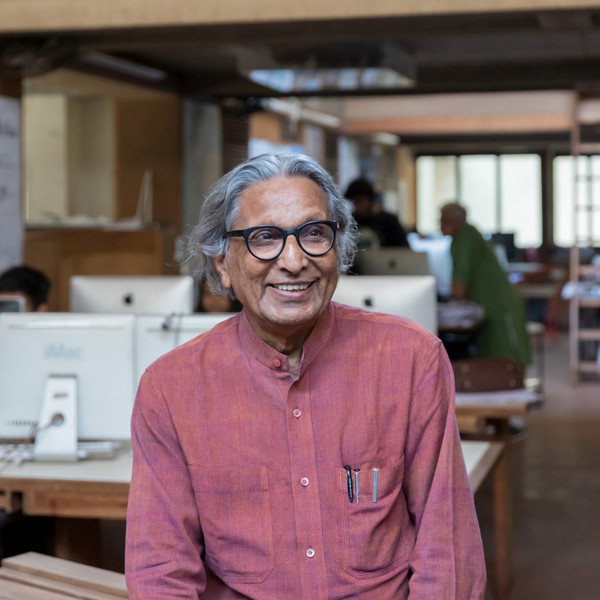


News

Dutch Designer Marjan van Aubel is one of the most renowned designers of recent years. Many of her smart design solutions integrate solar cells into furniture, windows, and other everyday items, making a practical contribution to a more sustainable future.
Read the Interview
Iwan Baan is one of today’s leading photographers of architecture and the built environment. He is known primarily for images
that narrate the life and interactions that occur within architecture.
Read the interview
Piet Oudolf’s famous gardens may appear wild and natural, but they are the result of meticulous planning. To him, working with plants means absolute freedom – an experience he would like everyone to share.
Read the interview
Superflux is a multidisciplinary design studio based in London. A leading protagonist of the critical design movement, Superflux addresses pressing social issues by designing speculative, fictitious scenarios of the future. Cofounder Anab Jain talks with Amelie Klein, curator of exhibition »Hello, Robot. Design between Human and Machine«, about what she would like to see in robots and her hopes for the future.
Read the interview
Shellworks is a London-based startup focuses on finding alternative solutions to plastic by working with nature. The curators of the upcoming exhibition »Plastic: Remaking Our World« spoke with Amir Afshar, one of three founding members, about the startup’s work process, philosophy, and recent relaunch.
Read the interview
For more than twenty years, Galina Balashova (b. 1931) designed the interiors for all major Soviet spacecraft and space stations. As part of the research for the exhibition »Here We Are! Women in Design 1900 – Today«, curatorial advisor Alyona Sokolnikova asked Balashova about the highlights of her career.
Read the interview
Dieter Rams is one of the most influential German designers of the past decades. His designs for the Braun company are legendary, his thoughts on design theory are equally relevant. On the occasion of the exhibition »German Design 1949–1989« Mateo Kries and Dieter Rams talked about the role of design in today's society.
Read the interview
Based in London, renowned British designer, creative director and educator Ilse Crawford has worked on numerous commercial and residential interior design projects and serves as head of department at the Design Academy Eindhoven. For the exhibition »Home Stories«, we talked to her about her work and her vast experience in the field of interior design.
Read the interview
Many surrealist artists have created ready-mades and other disturbing objects, unsettling our supposedly familiar world. André Breton and Salvador Dali are examples of these surrealists who took an interest in everyday objects.
Read the interview
The architect Balkrishna Doshi is one of the foremost pioneers of modern architecture in his home country. Jolanthe Kugler, curator at the Vitra Design Museum, talked with the 91-year-old architect about the melding of Indian traditions and Western modernism in his buildings, about his revolutionary social housing concepts and his formative years with Le Corbusier in the 1950s.
Read the interview
»Design Is Never Neutral« was one of the Victor J. Papanek’s (1923 – 1998) most important messages. To find out what this means twenty years after the designer’s death, the Vitra Design Museum sat down with one of the curators of the exhibition »Victor Papanek: The Politics of Design«, Professor Alison J. Clarke, Director of the Victor J. Papanek Foundation at the University of Applied Arts Vienna.
Read the interview
Together with his business partner Steve Rubell, Ian Schrager founded Studio 54 in New York City in 1977, whose roster of illustrious guests secured its reputation as the most famous disco of all time. Head curator Jochen Eisenbrand spoke with Ian Schrager, now a successful hotelier and real estate mogul.
Read the interview
Exhibition curator Jolanthe Kugler and director Mateo Kries spoke with Eames Demetrios, grandson of Charles Eames and director of the Eames Office, to get to the heart of Charles and Ray Eameses' working process.
Read the interview
The American sociologist Richard Sennett has studied the topic of urban living and community for over thirty years. In an interview in the context of the exhibition »Together!« he talks about the perils and possibilities of more open, porous forms of urban planning and communal living.
Read the interview
As part of the research for »Hello, Robot.«, curator Thomas Geisler asked Fiona Raby and Anthony Dunne about their take on the relationship between humans and technology.
Read the interview
The architects of the new Schaudepot, Jacques Herzog und Pierre de Meuron, spoke to director Mateo Kries and Rolf Fehlbaum, Chairman Emeritus of Vitra.
Read the interview
The products and installations created by the design studio Raw Edges are characterised by their playful use of colours and patterns. Raw Edges have made a name for themselves through their work for companies such as Kvadrat, Moroso and Louis Vuitton. They also set in scene »Alexander Girard« for the Vitra Design Museum. Shay Alkalay, one of the partners at Raw Edges alongside Yael Mer, spoke to chief curator Jochen Eisenbrand about the actuality of Girard's work.
Read the interviewI have no favourite material; anything can be used to create beauty if handled well.
Many Designers like collecting objects to create their own visual library.
A problem of the modernity is that it will solve and it will make easier. I think it’s not about solving, but about developing a culture of being. And then the problems will also shift.
I want to understand how design is connected to life.
Form must have a content, and that content must be linked with nature.
Design is the appropriate combination of materials in order to solve a problem.
Backgrounds

The Online Collection includes detailed information about selected objects from the collection and will be expanded continuously in the coming years. Here you won’t just find extensive details about each object, but also explanatory text and image materials, biographies of the most important designers as well as texts on the history of significant furniture manufacturers.
More


